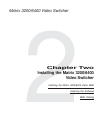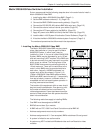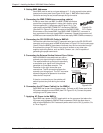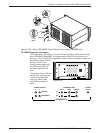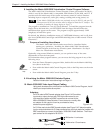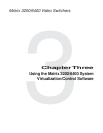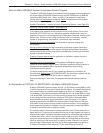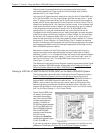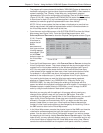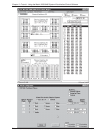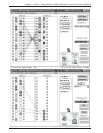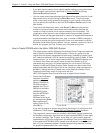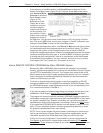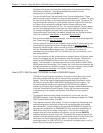
Extron • Matrix 3200/6400 Series • User’s Manual
Chapter 3 • Tutorial - Using the Matrix 3200/6400 System Virtualization/Control Software
Extron’s Matrix 3200/6400 System Virtualization/Control Program
The Matrix 3200/6400 System Virtualization/Control program communicates with
the Extron Matrix 3200/6400 System through the RS-232/422 port on BME #0
(defaults to 9600 baud, 8 bit, 1 stop, no parity). The program is required to
initially set the
Virtualization
and optional
Room
configurations for the system.
See the following two sections for details:
•
System Virtualization - creating a virtual I/O switching System -
(see Page 3-2)
• Rooming - how to create Rooms -
(see Page 3-4)
The program also presents all the functions found on the optional Front-Panel
Controller (FPC 1000), but in an interactive graphical interface, so it may be
used for full control or initial programming of the system. Because settings to the
Matrix (Ties, Presets, Audio config) are stored in the unit’s memory, several
modes of ‘programming’ are possible. It provides 4 major methods:
• Remote control and programming of the system in real time through the
RS-232 port.
• Saving system’s settings for later restoration to the same system (backup) or
copying to (programming) another system. Multiple configurations (programs)
can be saved to disk and any one quickly reloaded later, providing an unlimited
number of possible setups.
• Creating Program byte-strings for application to the Matrix system through a
third-party control system.
• Emulation (off-line) programming of the system’s settings for copying to
system at a later time or another place. Emulation mode also allows creation of
programs for any possible Matrix hardware configuration without being
connected to such a system.
To load a demonstration set of Ties, Presets and Rooms to your Matrix (or
Emulate one) Restore from the DEMO6400.MTX file which was installed with the
Windows Software. Use NEW.INI to clear all settings in a unit.
Note that pressing F1 from within the program will provide context-sensitive
Help.
An Explanation of VIRTUAL I/O SWITCHING in the Matrix 3200/6400 System
A Matrix 3200/6400 System consists of from 1 to 6 Switcher boxes (BMEs), each
of which may have as many as 64 inputs and 64 outputs. It is usually desirable to
have certain inputs (or outputs) switch together as a set: to
Follow
each other.
For example, if the system hardware consisted of a 64 x 64 Video BME and a 64
x 64 Audio BME, you’d want your Video monitor’s image and its Audio speakers
to be coming from the same source (maybe a VCR) and to follow each other
when switched to another source (perhaps a Laser Disc player). This type of
switching requires the two BMEs to communicate with each other so that they
both switch to the correct inputs to create the
follow
condition. In the traditional
and simplest configurations, hardware is usually designed to cause both BMEs
to switch to the same input (or output) number.
An example where Follow mode is
always
required is with S-Video where the ‘Y’
signal and the ‘C’ signal must be switched as a pair of input signals and a pair of
output signals Again, traditional hardware does this by causing the paired signals
to follow each other, either in a single box that is made only for S-Video or by
using two boxes designed for Composite Video and forcing them to follow each
other by switching to the same input (or output) number. Wouldn’t it be nice to
have a single Video switcher box that can be field-programmed to be either an
S-Video or Composite Video switcher? This is what Extron’s Virtual I/O
3-1




